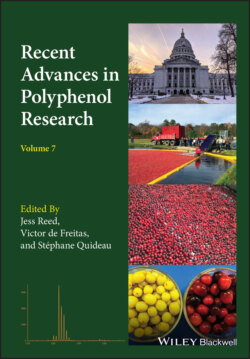Читать книгу Recent Advances in Polyphenol Research - Группа авторов - Страница 23
1.4.3.1 Unveiling the 6,8 Rearrangement Through Host‐Guest Complexation
ОглавлениеA step further to the study of the 6,8 rearrangement was achieved by host‐guest complexation. It is known that while cucurbiturils complex preferentially the flavylium cation (Basílio and Pina 2014), cyclodextrins prefer the chalcones (Petrov 2013b). The sulfobutylether derivative of β‐cyclodextrin (captisol) was used due to its better solubility in water, when compared with β‐cyclodextrin. The complexation with captisol was used to unveil the 6‐phenyl isomer from the 8‐phenyl‐5,7‐dihydroxyflavylium (Basílio et al. 2017). The NMR and UV‐vis spectrophotometry indicates that the fraction of Ct increases very significantly in the presence of captisol. Irradiation of this solution at pH=5.0 leads to a photostationary state, constituted by quinoidal bases A6 and A8 (Scheme 1.14). In fact, immediate acidification of the photostationary state to pH=1.0 shows the presence of the two respective flavylium cation isomers, with the 6‐phenyl isomer reverting slowly to the more stable 8‐phenyl isomer.
The host‐guest strategy was used to form the 6‐phenyl isomer from the 8‐phenyl‐5,7‐dihydroxyflavylium profiting from the capacity of cucurbit[7]uril to complex preferentially the former (Basílio et. al 2017) as well as for 6,8‐bromo‐apigeninidin (Basílio et al. 2016).
From bottom to top in Scheme 1.15, the 1H NMR spectra of the two isomers are shown. After addition of the host only the 6‐bromo isomer is observed. Addition of adamantine, which possesses a very high association constant with this host, permits to release and isolate the 6‐bromo isomer (Scheme 1.16). The system slowly reaches equilibrium by formation of the 8‐bromo isomer.
Scheme 1.14 Qualitative energy level diagram to account for the pH jumps and the photochemistry of the 6,8 rearrangement of 8‐phenyl‐5,7‐dihydroxyflavylium in the presence of the captisol host. Traced energy levels are tentatively positioned. The arrow of the excitation energy is not in scale.
Scheme 1.15 1H NMR of 6‐bromo‐5,7‐dihydroxyflavylium and its 8‐bromo isomer in the presence of cucurbit[7]uril.
Source: Adapted from Basílio et al. 2017. © 2017 John Wiley & Sons.
Scheme 1.16 Discrimination, isolation, and 6,8 rearrangement of 6‐bromo‐5,7 dihydroxyflavylium and its 8‐bromo isomer in the presence of cucurbit[7]uril. Reproduced from Basílio et al. (2017), with permission.
Source: Adapted from Basílio et al. 2017. © 2017 John Wiley & Sons.
